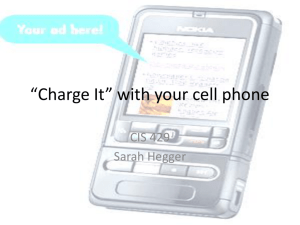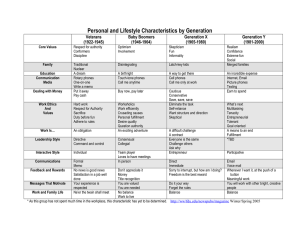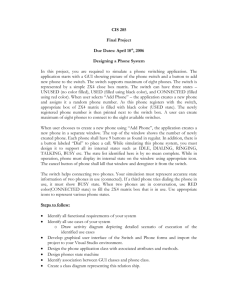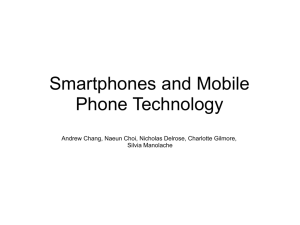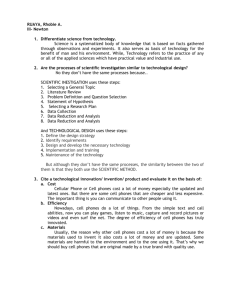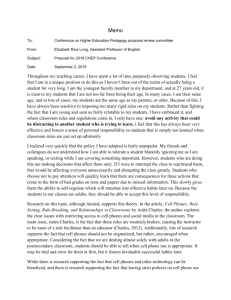TEL 355: Communication and Information Systems in Organizations
advertisement
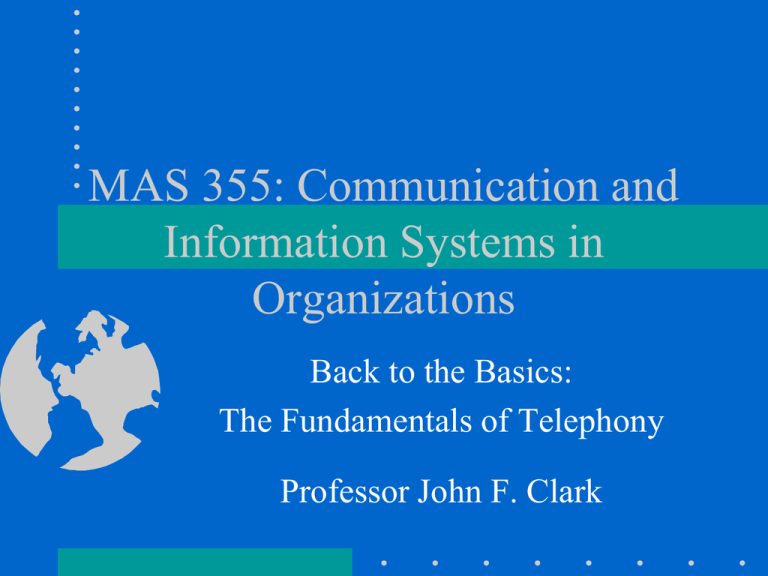
MAS 355: Communication and Information Systems in Organizations Back to the Basics: The Fundamentals of Telephony Professor John F. Clark Alexander Graham Bell Alexander Graham Bell Speaks Bell’s First Phone The Telephone Is: – The basic instrument of all communications technology – There are four primary types of data communications: • Voice, data, message, and image – Voice communication is Telephony – But the other kinds of communications make heavy use of phone lines The Telephone Has Five Parts: – Transmitter: is really a microphone – Receiver: is really a speaker – Ringer: bells, whistles, horns, and buzzers – Control unit: push buttons or rotary dial – Switchhook: signals the phone company and caller that the phone is either idle or in use Transmission of Sound: – Sound waves are converted to electrical energy – Transmitted over wires or another medium – Converted back to sound – Transmission is an analog signal – Frequency range is from 300 to 3,400 Hz Analog vs. Digital Transmission: – Analog is a continuous and continuously varying flow of electrical energy that varies with the frequency and strength of the sound – Digital is a stream of discrete on and off pulses called bits – Uses a technique called Pulse Code Modulation Analog vs. Digital Transmission: – Conversion from one to the other is done with a modem – It performs the function of modulation and demodulation – Digital is better quality because • No noise and distortion • More efficient and faster – More economical in the long run Telephone Lines: – Every telephone line is a twisted pair of wires (2X) -- it carries the transmission and the electricity for the phone – 2X wires connect phones to a central office – This local loop consists of three parts – Drop wire -- from house to pole to a: – Distribution cable -- runs down street on poles to a: – Feeder cable -- connects to the central office – These are often underground nowadays – Trunk lines connect one central office to another Twisted Pair and RJ-11 Feeder Cable Central Offices: – Originally, every phone went from one phone directly to another – As the number of phones increased, this became unworkable, plus: – Telephones were more valuable if they connected to multiple phones – Switching is connecting one circuit to another – The central office began as a switching center: Urban Telephone Lines Early Switch Operators London Switchroom Central Offices: – Each central office serves a specific geographic area – The size of area depends on the number of lines – The central office provides links to other central offices and to long distance providers – During times of unusually high use, central offices may be overwhelmed -- this results in blocking Automatic Switching: – The Strowger switch was fundamental to switching for decades • Banks of relays and switches occupying large buildings reaching from floor to ceiling – Technology improved from step-by-step system (10,000 users) to panel system (30,000 users), both mechanical and high maintenance – Then came electronic switching systems • Minimum of 100,000 lines, low maintenance • Stored program control switching allows revenue-enhancing programmable services Strowger Switch Strowger Switch Detail Strowger Phone Modern Switch Nationwide Numbering Plan: – Nation is divided into numbering plan areas, each with an area code – Seven digits to dial within an area, ten outside the area – "1" signals long distance and "0" calls the operator, so 2-9 are left to begin prefixes – Mathematically no more than 8 million numbers per area code – Private phone systems may have other single-digit codes World Numbering Plan: – International Telecommunications Union • Is a United Nations Agency • The ITU-T (as the CCITT) established worldwide numbering plan • There are nine international zones with prefixes beginning 1-9 which may be followed by another one or two numbers • Highest use areas receive single-digit codes – North America has "1" Single-Line Systems: – Consist of an individual line and one or more telephones – each line can support several extensions – may be residential or small business, but business charges are higher – largest market for phone business – capable of numerous service features, as well as service inherent in the phone Key Telephone Systems: – For the small business user – Permits multiple lines to terminate on one telephone with the punch of a button – Many features are inherent in the system, such as hold and call pickup Key System Private Branch Exchanges – On-premises computer-based switching system for large organizations – Calls between stations are dialed directly, usually with a single-digit prefix – Can be purchased, leased, or rented from AT&T, telcos and many other vendors – Many highly-specialized services available – Centrex is a service offered by telcos where the switch remains at central office but is dedicated to one business Telephone Sets and Dialing: – Only basic black phones were available until the late 50s – Now there are a wide variety, with easy modular hook-ups – Rotary phones used dial pulsing signaling one digit per second Basic Black Phone Princess Phone How to Sell a Princess Phone Telephone Sets and Dialing: – Push-button phones use Dual Tone Multifrequency (DTMF) -- sounds as a chord -- 10 digits per second • Much faster dialing speeds • Better dialing accuracy for mechanical and mnemonic reasons – Necessary for "talking" to computers Trimline Phone Cordless Phones: – Base station connected to phone line and cordless handset – Uses low-power radio transmission – Absolutely no expectations for privacy Cellular and PCS – Cellular may be analog or digital, but is primarily digital since 1997-98 – Must be within range of a compatible cell tower – Personal Communications Systems (PCS) are digital services – May be a satellite-based service – Incorporates phone service with paging, email, Internet access
